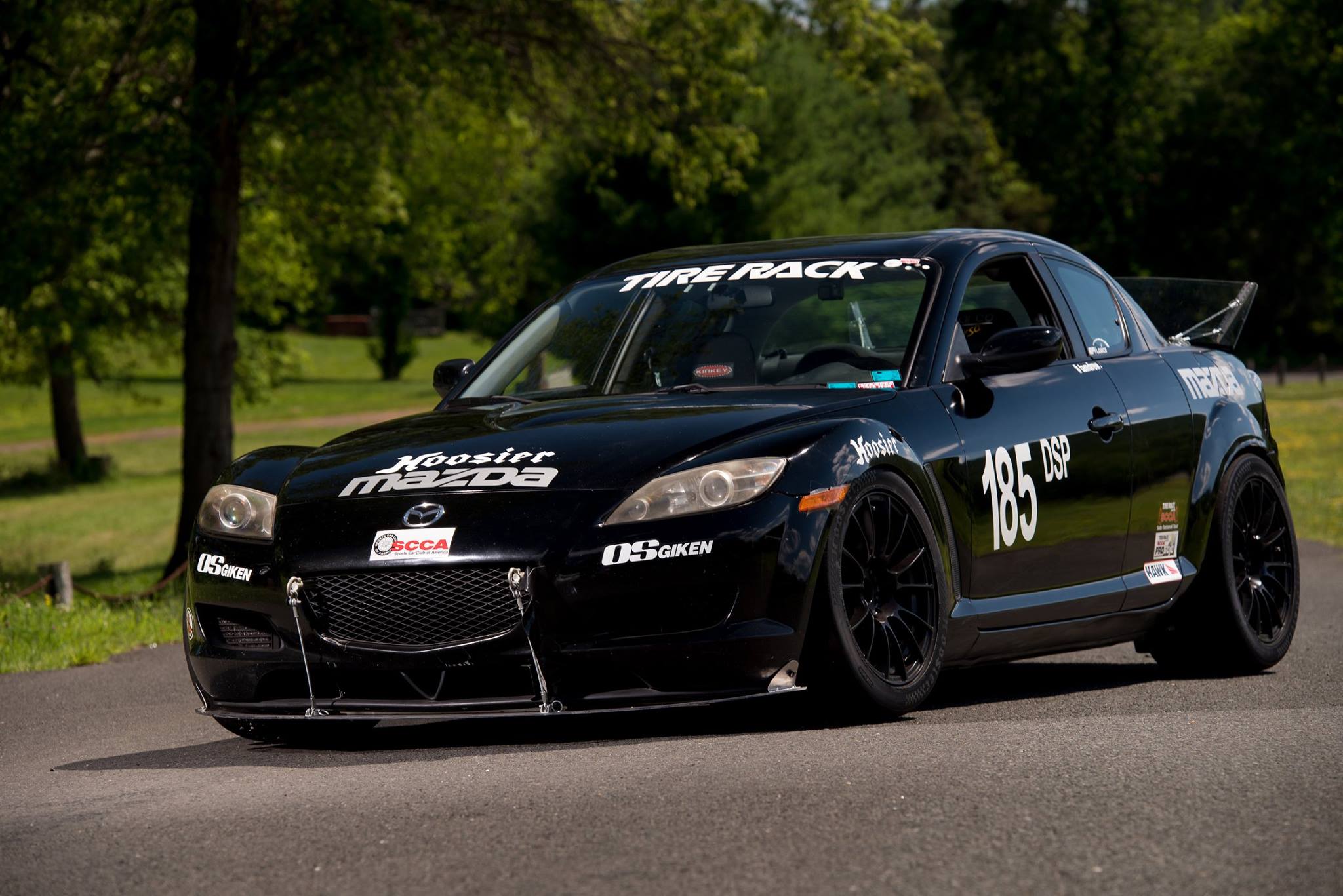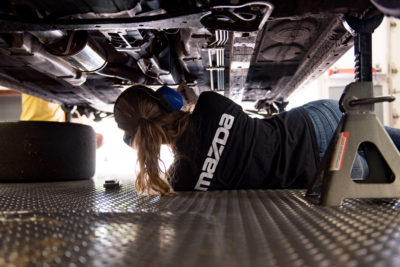Solo Racer Tamra Hunt runs us through what it took to transform her 2005 RX-8 into a DSP machine. If you are considering moving into this class this is great place to start for some tips and tricks on how to do it on budget!
My fiancé and I built the entire car (including car purchase) for about $15,000. In our first season competing in this car I won thousands of dollars in cash and prizes, and I also won 2nd place at the Solo National Championships in Open DSP. Today, I’ll run through the basics for the class and what it took to get to where I am today with the car.
The Basics
SP allows you to use wide wheels, sticky race tires, coilovers, bolt-on power adders and tuning, race seats, aero, and more. If you want to go crazy, you can do many custom adjustments as well, including custom super light brakes, throttle bodies, custom control arms, custom bushings, titanium exhaust, cooling system mods, custom intake manifolds, etc. However, as with all things, you get more “bang for the buck” with some mods more than others.
The Budget: locally very competitive
- $4,000-$6,000: The car. You can either buy a Mazda RX8 in need of an engine rebuild (I bought mine for $2,000 and put about $2,000 in parts into the motor rebuild, which we did ourselves), or buy one with a good compression test. Just make sure it is well maintained with fresh coils and spark plugs.
- $2,600: Wheels/Tires. The easy button is to buy a set of 17×10 wheels with an offset of around 45-50 (mine have a +52 offset and I used 5mm spacers) and fit 275/35/17 Hoosier A7 tires. These will fit with a basic fender roll and will make you competitive right off the bat. I bought my wheels brand new for $1200, and the rest of the budget is a set of tires. Some people also fit 285 or 295 Hoosiers in 17” or 18” sizes, but those get progressively harder to fit (significant pulling and alignment changes to fit). We have also ran 295s, but I’m not sure which is faster since they hurt the gearing (taller), are heavier, and make the car wider.
- $4,000: Penske coilovers. Now this category might give you sticker shock, since there are plenty of sub $1,000 coilover kits on the market. However, your shocks make the single biggest difference in performance after sticky rubber. I opted to skip a variety of other modifications so I could fit Penskes in the budget, and never regretted it. Personally, I went with a set of Penske 7300 double adjustable non-remotes from Anze Suspension out of NY. The price tag included custom valving from Anze (the magic is in the valving) and the full setup to bolt into the car.
- $550: Mazda Motorsports front sway bar. I am running the new splined bar from Mazda in the .25” wall size.
At this point you are around $11k into your DSP car (including car). Is it competitive? YES. In fact, I brought our car out with exactly the mods listed above (no tune, no bolt-ons, no lightening mods – literally wheels, tires, and amazing coilovers). The car took top index at a local event on its first outing! However, it was not yet “nationally competitive.”
The Budget: Nationally competitive
To take the car to the “next level” per se, it will require a few additional modifications. With budget in mind, I chose the next few mods wisely.
$0: Basic lightening mods. I removed all of the free items I could, including the air conditioning system (18lbs), the stereo and speakers (11lbs), and air pump (5lbs – technically cost $18 since I had to put a block off plate on the OEM header). The class requires you keep a full interior.
$100: Catless midpipe. If you spend more money you can buy a bolt on option, but we chose to weld it ourselves. We bought some pipe and a Vibrant resonator and made our own catless midpipe. The car already had a custom, single exit catback on it previously, so budget another $150 or so for that if you don’t have it yet. This mod will gain you approximately 5 horsepower. You can also do a high flow cat and still net most of the horsepower gains if you prefer and keep the car street legal.
$300: Aero. This is where your fab skills will come in handy. I bought some Lexan, threaded rod, rod ends, some quick release pulls, and stock to make brackets. We mocked up the aero using cardboard and then cut it to fit, and installed everything on the car. It took us two evenings after work to make the aero for both the front and rear of the car. And if you’re wondering: YES, it actually did make a noticeable difference on the autocross course. We actually had to change our setup quite a bit to balance the car back out once we added aero (we were crazy enough to do this at a national event, and we WON).
$0 another set of Hoosiers. If you’ve done the above, your car is capable of winning nationally SOMETIMES. We now had another set of fresh Hoosiers after my win at the NJ ProSolo in L1 and the Ladies Challenge.
$500-$1,000: Race seats & brackets. Anything from a relatively cheap Kirkey race seat to something more luxurious. I picked up a Sparco Corsa seat used on Craigslist to save some money, and mounted our Kirkey passenger seat directly to the floor to save on weight (about 10lbs installed). The driver’s seat is on aftermarket sliders, since we have multiple drivers in the car. With proper race seats, we have continued to use the stock seatbelts without complaint. We removed 37lbs with this mod.
$200: Bushings. My car had around 90k miles on it so many of the bushings were starting to wear out. I bought a set of Powerflex and Energy Suspension bushings to install in most of the suspension, and we also bought Mazda Motorsports offset upper control arm bushings. In addition, we purchased some Delrin stock and custom made our diff bushings and one other suspension bushing that was backordered. The bushings really helped the car handle more consistently (tightened up the responsiveness by removing the bushing flex) and helped the tires follow the ground better since the bushings could rotate smoothly.
$150: lightweight battery and custom bracket. We bought the 3lb Idemitsu lithium battery and fabricated a battery holder for it. It took off 27lbs.
$300-$800: Cobb tune. I picked up a used Cobb Accessport for $300. Some people opt to DIY the tune, to save money. However, we wanted to get as much power out of the car as we could and also know we had a safe tune, so we opted for a professional tune from EFI Logics in Bethel, CT. The car is now making 214whp.
$0-$1500: Differential. Rear differentials frequently come down to driver preference, as different diffs can change the handling characteristics of a car significantly. We ended up running an OEM Mazda Torsen diff, but this might not be the right solution for you. I recommend you research to decide which one to go with.
$200: Mazda Motorsports steering wheel. Not only does it look great, but it made the steering rack feel faster and more precise. It may not make the car faster, but it helped make the driver find time easier.
Total for national prep: $3000-$5500
$100 – Infinite: We tinkered with a few other mods, including custom spherical shock top mounts that we made in our garage, a new exhaust, and I found a used header for a great deal (didn’t pick up much power but did save some weight). Overall, we haven’t spent much money in the “other” category. We are still running the OEM airbox, but a cold air intake is also another area to potentially find some gains. Lightweight brakes, more expensive lightweight wheels, custom control arms, standalone ECUs, etc. are all possibilities in this class if budget allows.
All in total to build a competitive DSP RX8: $14,000 to infinity
The final piece of the equation is the tow rig, one of the largest perceived barriers to entry for a Street Prepared build. We also bought ours on a budget, with a $2,600 brand new steel car trailer and a $2,800 1998 Ford E-350 7.3L Diesel van (one owner with original window sticker! The deals are out there). While diesel trucks tend to be very expensive, you can get great prices on diesel vans, with the side bonus of way more inside storage for hauling stuff to race events.
All in tow rig and competitive race car: under $17,000-infinity
Photo credit to Mike Duval Photography



 ACCESSIBILITY
ACCESSIBILITY